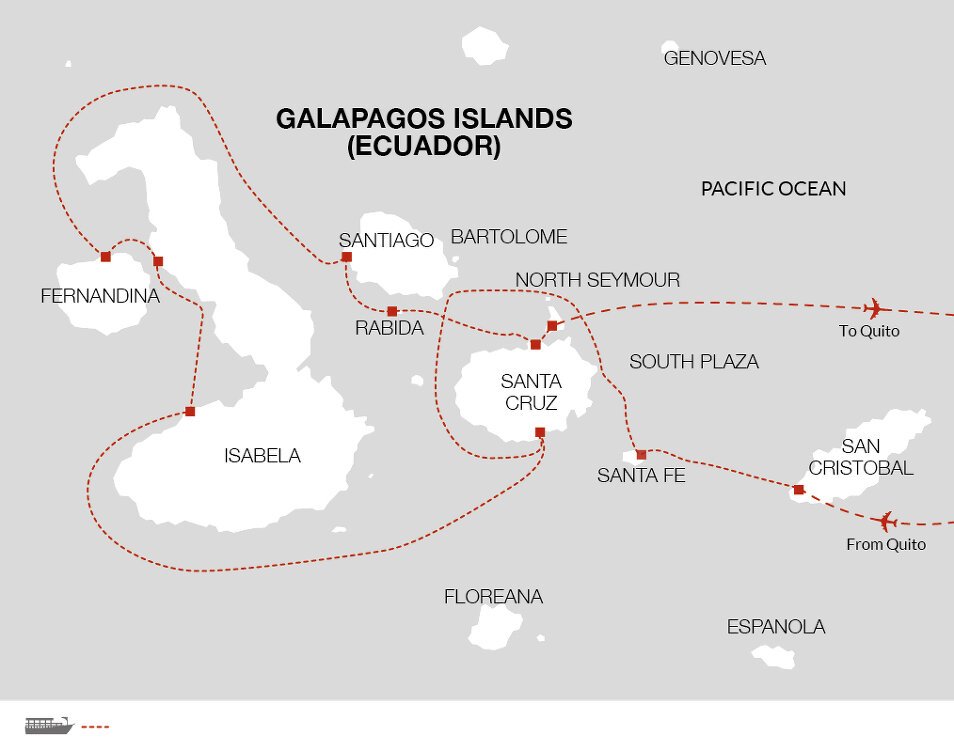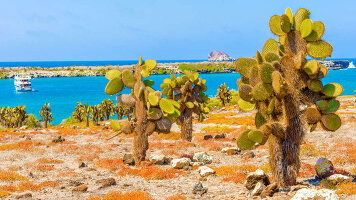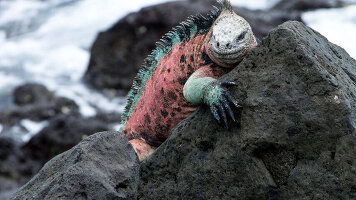
Overview
Itinerary
Arrive in Puembo, a quiet rural neighbourhood of Quito located around 20 minutes from the airport and 45 minutes from the downtown city centre.
Ecuador's mountain capital is, at 2,850m, the second highest capital in Latin America, lying in a narrow valley at the foot of the Pichincha Volcano. Arriving into the city by plane is quite spectacular as you approach over snow-capped mountains and extinct volcanoes - a window seat is recommended! You will be met on arrival at Mariscal Sucre International Airport (UIO) by a driver to take you to this evening's hotel, where more information will be given to you about tomorrow's schedule.
The hotel is a tranquil, colonial-style property with a large garden and swimming pool. It's located in the countryside suburbs of Quito, near the airport; perfect for an early start tomorrow. The hotel can help organise a taxi for you into downtown Quito if you arrive early in the day and wish to visit the city. Stay: Hotel Rincon de Puembo (or similar) (Comfortable)
Today transfer to the airport early for your flight to the Galapagos Islands via Guayaquil (refueling stop only, you will not disembark the plane).
Lying on the Equator, 970km west of the Ecuadorean coast, the Galapagos National Park is a unique collection of islands, formed by volcanoes over hundreds of thousands of years and consisting of six main islands, 12 smaller islands, and over 40 small islets, each one supporting a distinct and unique flora and fauna, including prehistoric creatures found nowhere else on earth. This desolate and fantastic habitat was discovered in 1535 by Fray Tomas de Berlanga. Charles Darwin visited the islands on the Beagle exactly three hundred years later, in 1835. He observed the total isolation of the giant reptiles and other creatures, and this played a substantial part in his theory of evolution.
Of the extraordinary animals to be found in the Galapagos many are reptiles, such as the great tortoise, large land iguanas, numerous lizards and three species of non-poisonous snakes. There are also several species of turtle, which come ashore to mate. Up to three quarters of a million seabirds flock to the islands, including a third of the world's blue-footed boobies, frigatebirds, pelicans, cormorants, albatross and petrels. Only 35cm tall, the Galapagos penguin can be seen swimming among tropical mangroves, whilst offshore it is common to see dolphins, sea lions and fur seals playing in the water. Fearless though not tame, the extraordinary wildlife is often inquisitive and the opportunities for photography are superb.
The Galapagos National Park charges a visitor fee of $100 USD (subject to change), payable in cash on arrival, which funds park maintenance and supervision in the Galapagos, as well as ecological study, conservation and infrastructure development in Ecuador's other national parks. Entry fees and the funds they generate for the national park system are among measures taken by the Ecuadorian government to protect its natural heritage.
At Baltra Airport, a guide will meet us to help us collect our luggage and accompany us on a short bus and a taxi boat ride across to Santa Cruz Island. This afternoon we visit the Fausto Llerena Breeding Centre, where we can observe tortoises that come from various islands of the archipelago - at Fausto Llerena they are breeding tortoises only to repopulate areas where their populations have been affected by non-native wildlife (predominantly feral dogs). One of the main attractions here is the embalmed Lonesome George - estimated to have died at between 93 and 109 years of age, Lonesome George is recognised as the last of its kind, and as a symbol of the efforts invested into conserving endangered species.
After a visit to the centre, we continue to the port of Puerto Ayora, where we board our stylish vessel for the next week - the Archipel I. Stay: Archipel I (or similar) (Comfortable) (B/L/D)
The peninsula of Cormorant Point forms the extreme north cape of Floreana, and at the landing beach we will be welcomed by a small Galapagos sea lion colony. Spot schools of stingrays hiding in the sandy bottom of the beach and, during the first months of the year, witness Pacific Green turtles coming ashore to bury their eggs. From Cormorant Point we head to the snorkelling spot at Devil's Crown, a coral reef surrounded by an eroded volcanic crater and the perfect home for marine life. Look out for small sharks, rays and schools of tropical fish. You may even spot Galapagos penguins here - this spot is the only place in the south-eastern archipelago where the Galapagos penguin resides.
Later in the afternoon, we stop at Post Office Bay. A barrel was placed here in the late 18th century by English whaling vessels to be used as a post office. Passing ships would stop to leave mail for loved ones, collecting at the same time any mail destined for ports on their itineraries. Today the box is used mainly by tourists, and you can drop off your own postcard, picking up an unstamped letter to post for someone else. You can also climb the small basalt cone at the Baroness Lookout for panoramic views of the coastline. This viewpoint was the famous spot of one of Floreana's first settlers, the eccentric baroness and self-proclaimed 'Empress of the Galapagos' Eloisa von Wagner. Stay: Archipel I (or similar) (Comfortable) (B/L/D)
Today we spend some time exploring Espanola Island, the southernmost island in the Galapagos archipelago and home to several wildlife species, including masked and blue-footed boobies. We'll sail into Gardner Bay, an excellent swimming and snorkelling site. Strap on your snorkel and if conditions allow, see an abundance of sea life including young sea lions and large schools of surprisingly big tropical fish, including yellow-tailed surgeonfish, king angelfish, and bump-head parrot fish.
In the afternoon, we head to Punta Suarez, where a hike to the top of the cliff makes for spectacular photo opportunities. This rugged point on the western side of Espanola Island is spectacular; gargantuan waves break on jagged cliffs and large bird colonies thickly populate the interior of the island. There is a distinct feel of desolate wilderness here. The waved albatross is seen here from April to December during its mating/nesting season. This bird leaves land between January and March each year to make its annual odyssey far out to sea. Amazingly, Espanola is the nesting site of virtually the entire world population of this species, with more than 12,000 pairs residing here. Large numbers of masked and blue-footed boobies are also found here, red-billed tropicbirds dash madly through the air, and both marine iguanas and sea lions are common. A huge blowhole at Suarez Point, where the surf is forced through a natural rock formation spouting seawater 15 to 20m into the air, adds to the island's impression of untamed beauty. We follow the trail through a rookery and learn the geological history of the island from our naturalist guide, including its dramatic volcanic features, climate, flora and fauna. Stay: Archipel I (or similar) (Comfortable) (B/L/D)
The wind-sculptured volcanic cliffs at Pitt Point make up the extreme eastern end of San Cristobal, and therefore of the whole archipelago. These cliffs were the first sight of land when HMS Beagle and Charles Darwin arrived on the 15th September, 1835. On the small green-sand beach, we'll be welcomed by a group of barking Galapagos sea lions. This is a bachelor colony, where males usually relax and prepare themselves for fighting and mating.
In the afternoon, we land at Witch Hill, where the primary attraction is snorkelling off the coral-sand beach. This was one of the first sites visited by Charles Darwin in this inaugural expedition, and has an impressive landscape, where we may see pelicans, blue-footed boobies and swallow-tailed gulls, as well as marine iguanas. Stay: Archipel I (or similar) (Comfortable) (B/L/D)
The tiny island of Lobos has some wonderful wildlife encounters to experience. On foot, view the sea and shore birds nesting and feeding. Spot a small colony of blue-footed boobies, or nesting frigatebirds, who mate here with clumsy dances - heaving their striking blue feet or blowing up their balloon-sized scarlet pouches - as well as finding a large colony of sea lions.
This afternoon, some of your fellow passengers may depart the boat and others may join for the second half of your trip. While this changeover happens we'll have time to relax aboard the boat, reclining on the loungers situated on the sundrenched topdeck, or borrowing a book from the onboard library and learning about the wildlife still to come. Stay: Archipel I (or similar) (Comfortable) (B/L/D)
After breakfast this morning we head out to explore Santa Fe Island, giving us a chance to mingle with the iguanas. Located in the southeastern part of the Galapagos, this island is not volcanically formed, and is therefore mostly flat. Scientists theorise that this is the oldest island on the archipelago, and it is home to several endemic species including the Galapagos hawk and Galapagos mockingbird, as well as one of the two land iguana species on the islands. We'll disembark and explore on foot, where giant prickly pear cactus are dotted around.
We continue sailing to South Plaza Island, one of the smallest islands in the Galapagos. A large colony of noisy sea lions, numbering about 1000 bulls, cows and pups, has its prime habitat on the smooth rocks. We will walk along a path through a cactus forest and view a combination of dry and coastal vegetation, populated by land iguanas, which can be seen sunning themselves or feeding on opuntia pads and fruits. Swallow-tailed gulls, which nest on the rugged southern cliffs, are usually seen, along with tropicbirds and Audubon's shearwaters. Stay: Archipel I (or similar) (Comfortable) (B/L/D)
In the morning we'll arrive at a small little island off the southern tip of Santiago Island called Sombrero Chino or 'Chinese Hat', named for its unique shape. Its tilted cone is made up of ancient lava that run down to the coast. Here it is often possible to see Galapagos penguins and the abundant marine life, including rays, turtles and sea lions.
We sail to North Seymour in the afternoon, which is home to sea lions, marine iguanas, swallow-tailed gulls and blue-footed boobies. North Seymour Island is probably the most exciting island photographically. Birdlife abounds, and close to the trail you will find many nesting pairs and young chicks. North Seymour is also home to the Galapagos' largest colony of magnificent frigatebirds. Stay: Archipel I (or similar) (Comfortable) (B/L/D)
En route back to the airport, we'll travel through the mainland of Santa Cruz and make two stops. The native scalesia forest of El Chato Tortoise Reserve is the best place to search for Galapagos giant tortoises in their most authentic setting. Though it can be quite moist and muddy, the visit will be an adventure, trying to spot the giant creatures silently leave their favourite ponds. While on the mainland, we'll also visit the Twin Craters - found on either side of the road leading to Puerto Ayora. These impressive formations were formed by magma domes, which hardened on the outside while the lava continued flowing inside, leaving huge and empty magma chambers that eventually collapsed into two large holes. The craters lie within a lush scalesia cloud forest, a high-altitude plant species that is endemic to the Galapagos. This area is also home to the carpenter finch, which uses tools to search for food.
We'll then return to Baltra Airport, from where you fly back to Quito and transfer to your hotel. Stay: Hotel Rincon de Puembo (or similar) (Comfortable) (B)
The trip ends after breakfast at the hotel in Puembo, Quito.
There are no activities planned today, so you are free to depart at any time. Pick-up times for your airport transfer to Mariscal Sucre International Airport (UIO) will be re-confirmed locally. If your flight is departing later in the day, luggage storage facilities are available at the hotel. If you would like to book additional nights in Quito at the end of your stay, these can be arranged either at the hotel in Puembo, or in a hotel in downtown Quito.
We recommend spending extra time in Quito, or adding to your nature-based holiday by booking our four-night Amazon extension package (trip code: AE). (B)
Trip Inclusions
- Spend seven nights cruising with a naturalist guide and experienced crew
- Discover an underwater paradise and a volcanic landscape from the comfort of a catamaran
- Find giant tortoise in the highlands of Santa Cruz, look for sea turtles on snorkelling excursions, and see land iguanas crawling on cacti-strewn islands
- Moderate pace tours are ideal if you want a holiday which combines exciting activities and experiences with plenty of time to relax and unwind. Typically you'll be active and busy for part of the day but then also have time to rest and recharge your batteries.
- Accommodation, itinerary and inclusions subject to change.
- Price is for land, cruise and internal flights as specified. Flights not specified are not included
Cabins
Download Brochure

Explore Worldwide Small Group Adventures (2025-26)
Dates & Pricing
 USD
USD
A definite departure means minimum numbers have been reached for this departure to operate. Your Global Journeys Travel Advisor will check the availability of your departure date when you Inquire. Additional savings may apply. T&C’s apply.
Tour & cruises prices are per person. Prices shown have savings applied, are subject to availability and may be withdrawn at any time without notice. Pricing and trip details are correct at this point in time, however are subject to confirmation at the time of booking and are subject to change by Explore. For cruise itineraries, cabin images are sourced from the cruise-line and should be treated as indicative only. Cabin inclusions, upholsteries and room layout may differ to the image(s) shown depending on the ship selected and your sailing dates.









